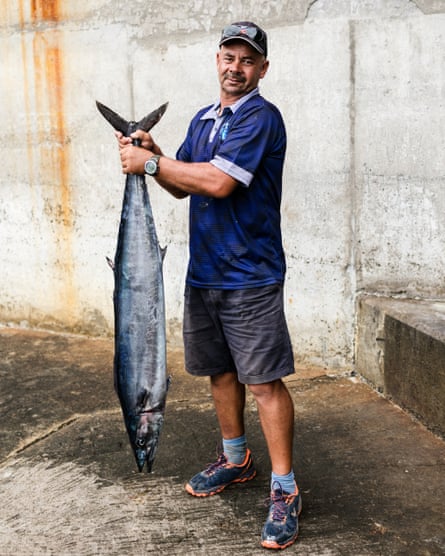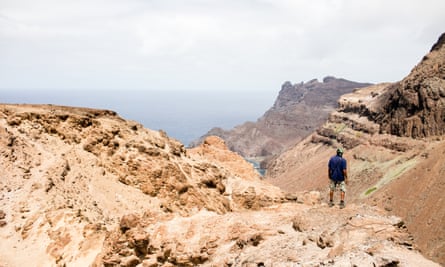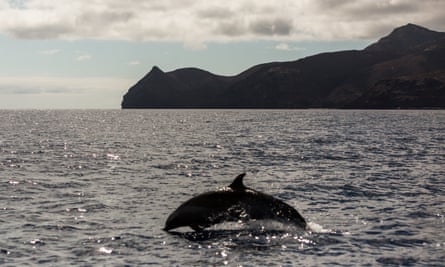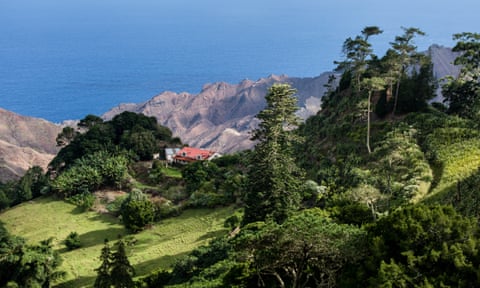Something is circling our boat in the middle of the South Atlantic Ocean. We are off the coast of Flagstaff Bay, sailing in slow motion on glassy-calm water, and a frenzy of dorsals and dual-lobbed fins have appeared as if in pursuit. It’s quite something to see a whale shark the size of a school bus in the water and quite another to see a dozen of them, then put on a snorkel and plunge straight in as if you are bait. “Don’t forget to breathe,” says Keith Yon, our boat captain for the day. “They’re so much bigger and scarier when you’re in the water. In a nice way, of course.”
The Guardian’s product and service reviews are independent and are in no way influenced by any advertiser or commercial initiative. We will earn a commission from the retailer if you buy something through an affiliate link. Learn more.
Admittedly, shark-infested waters are not for everyone. But the comings and goings off St Helena’s shores make it a Shangri-La for nature lovers. This season Keith has chalked up a few hundred sightings, including an intense Blue Planet encounter with 27 whoppers only last week. Indeed, when it comes to raw spectacle, the far-flung British territory soundly beats the Galapagos and the Maldives, plus you won’t find the vulgar chaos of tourist boats crowding the water here. The dark blue sea is so empty – so vast and infinite – you sense it is cloaked in something almost magical.

Unsurprisingly, visitor numbers are on the rise in St Helena, and the island is on the cusp of becoming more popular. New connecting flights to the island from Cape Town launch in December (in addition to those from Johannesburg) making it increasingly accessible from the UK. The island’s nearest neighbours are 1,500 miles away to the south in Tristan da Cunha, and beyond that is Antarctica. Living this far from anywhere makes the inhabitants – or “Saints” – friendly and familiar.
If one place sums up the geographic absurdity of St Helena, it’s Jamestown, the island’s economic and social nexus. The town is caught in a tight embrace at the bottom of a steep-sided valley, surrounded by layers of volcanic ash and a rugged fringe of sun-seared coastline. There are pastel-toned houses, sweltering palm trees and colonial relics – stark reminders of imperialist ideals and slavery. All are echoes of the East India Company, which settled the island in 1659.

Go into any of the island’s satellite towns and there’s plenty more history to discover: from time-stopped 19th-century Longwood House, where Napoleon was exiled after Waterloo, to Plantation House, the residence of the governor and home to Jonathan, the 187-year-old giant tortoise that tootles about on the front lawn. You can also appreciate Edmund Halley, who built an observatory among the wispy flax grass of Diana’s Peak, St Helena’s sugar loaf mountain, and applaud Charles Darwin, who came to catalogue endemic birds and insects.
I’m staying at the Consulate Hotel, in a scruffily chic room wedged between a lawyer here to update maritime statutes and a coastguard in training. An unannounced yachting party arrives in the midst of a transatlantic crossing and the hotel fills after one mass check-in. “Tonight’s entertainment is a sing-song at the town piano,” says owner Hazel Wilmot, fancifully. “You’ll all join in, of course.” As it turns out, they do.
The hotel is ideally placed for exploring the island’s easily accessible nooks and crannies. At its southwest tip, there is the black sand curve of Sandy Bay, while a bumpy Land Rover hunt for the endemic wire bird at Cox’s Battery reveals a mix of cloud forests and farmland that wouldn’t look out of place in Norfolk. Every so often, there is a sense of the familiar, but also fleeting volcanic panoramas that could make it the Congo. If you need any indication of how St Helena is changing, then you can visit Welsh expat Paul Hickling for a £5 tasting at the world’s remotest distillery, discreetly tacked on to the back of his house. After a quick nose around, I’m game to try his White Lion rum, nicknamed “gunpowder in a glass”, followed by a shot of prickly pear “tungi” spirit, a teeth-scraping moonshine.

Elsewhere, the food is just as intensely memorable. Inside the former stables of Anne’s Place in Jamestown – all shipwreck chic and masthead flags – the specials are wedges of wahoo and tuna, battered golden or grilled, for £8. On a nearby hilltop house, after a cooking lesson with Derek and Linda Richards at their homestay, I gorge on a lifetime’s-best platter of fishcakes made with squidgy tuna belly and thick cuts of red chili.
The food is a triumphant if curious blend of British, Creole and African, and what accompanies it is a sweet black pudding, stuffed with rice rather than grain, followed by exquisite homegrown coffee made with green-tipped Bourbon arabica. As if to emphasise this wildly remote island of extremes, I take a final boat trip on my last morning and within five minutes the ocean soon swarms with hundreds of pantropical dolphins. They bask in our wake, then begin popping out one by one like corks.
Along with its stunning wildlife, the allure of St Helena is its scale – it’s the size of Jersey, so you can see all the sights on this island very easily, and still have time to kick back, relax and experience life at a different pace on this wildly remote gem at the end of the world.
Way to to
British Airways flies from London to Johannesburg (from £638) and Cape Town (from £744). From there you take an additional flight to St Helena (from £750) with Airlink. Rooms at the Consulate Hotel from £150 B&B. Whale shark snorkelling costs from £20 (sthelenatourism.com). A homestay cooking lesson costs £50 (islandimages.co.sh)

Comments (…)
Sign in or create your Guardian account to join the discussion